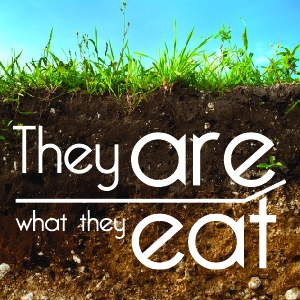As long as farmers have been farming they have tried various methods to improve the plant nutrition in their crops.
In early times farmers noted that if they planted the same crops on the same lots the latter crops were not as healthy. They found the easiest way to grow better crops was to start a soil block rotation, cultivating a different crop in a different block each year. They also found that if they left the crop residues on the land after harvest, and ploughed it back into the soil, this would decompose and improve the soil fertility. And so a basic from of fertilisation was invented.
With the advent of science in agriculture in the beginning of the 19th century, farmers started realising that plants utilise certain elements and nutrients from the soil. Along with chemists, they then began experimenting with soluble chemicals such as gypsum and ammonia, hence the modern science of inorganic fertilisation was born. Today plant and soil nutrition has evolved into a complex science. It is not easy for me to unpack the whole of this modern science into a brief article, so let us rather look at the basic fundamentals.
Plant nutrition refers to the need a plant has for the basic chemicals in order to grow. Fertilisation is the application of these basic chemicals to the soil so as to supplement the chemicals that naturally occur in the soil. Plants require the structural elements of carbon, hydrogen and oxygen; as well as micro-nutrients and macro-nutrients in order to survive.
Macro-nutrients are the primary nutrients a plant takes from the soil. Macro-nutrients can further be broken down into the primary macro-nutrients, these being nitrogen, potassium and phosphorus, which are quickly leeched by the plant as it requires a lot of these to perform basic metabolic processes.
Secondary macro-nutrients are magnesium, calcium, and sulphur. Secondary macro-nutrients are not always depleted from the soil and are not required by plants to the same extent as the primary nutrients. These are also often easily replaced by simply ploughing the crop residue back into the soil.
Micro-nutrients are trace elements that a plant needs very little of: these being zinc, iron, boron, chlorine, cobalt, copper, manganese, and molybdenum. All of these are necessary for healthy plant development.
Plants do not, however, grow in thin air. They are reliant on the soils they find themselves growing in. Soils can vary extremely from one location to another. A good soil is usually made up of a weathered rock fraction as well as decomposed organic material. An easy way to explain this is to look at the difference between a pure sand soil and a clay:
In a sand soil you have larger particles of even size and almost no organic components. These sand soils tend to dry out very quickly as water flows freely through them, therefore they will not be high in the necessary nutrients and elements as these would have been easily leeched by the water passing through.
On the other hand, a clay soil is made up of extremely fine particles, so that when they get wet the water around each of these tiny particles has a cohesive affinity to the particle next to it, thus pulling all the particles together to form a tacky clay. This cohesion does not allow water to move through freely and thus one might find an over-abundance of plant nutrients. It does make sense that a plant would not do well in either of these two extremes. Plants need a happy marriage of sand, clay, and decomposed organic material. This constitutes a healthy structure which has the ability to hold water as well as oxygen, creating an optimal environment for plant growth.
Plants do not, however, grow in thin air. They are reliant on the soils they find themselves growing in. Soils can vary extremely from one location to another. A good soil is usually made up of a weathered rock fraction as well as decomposed organic material. An easy way to explain this is to look at the difference between a pure sand soil and a clay:
In a sand soil you have larger particles of even size and almost no organic components. These sand soils tend to dry out very quickly as water flows freely through them, therefore they will not be high in the necessary nutrients and elements as these would have been easily leeched by the water passing through.
There has been much debate about organic versus inorganic soil fertilisation and one struggles to form a conclusion as to which one is essentially better. A little known fact is that with organic fertiliser only 0,4% of the total weight of the fertiliser used has a plant nutrient value, therefore the large quantities required bulk up the soil. On the other hand inorganic fertilisers do not bulk up the soil and as much as 64% of their weight is directly available as plant nutrient. As one can see, organic nutrients need to start breaking down in the soil before it becomes available to the plant, whereas inorganic (or water soluble) nutrient is far more directly available to the plant. Organic fertilisers or composts could therefore be used to improve the general soil structure and inorganic fertilisers used for plant nutrition. In my mind, a balanced use of both inorganic and organic fertilisers should yield optimum results.
In agriculture or large scale mono-cropping it is not feasible to use vast quantities of organic fertilisers to the soil as the large quantities required would just not be practical. Thus the only organic fraction added would be that from the previous crop, which is ploughed back into the soil. It stands to reason that time would be required before this organic material has broken down sufficiently to be available to the plants as nutrients. It therefore makes economic sense to make use of inorganic or water soluble fertilisers.
However, one should always have the soil tested in order to determine exactly what plant nutrients are deficient so as to not over fertilise the soil, as this would also result in an unfavourable condition for plant growth.
There are companies that have developed fertilisers that can be applied in various ways including water soluble and granular, or a combination of both. Product ranges have been developed in order to correctly balance the depleted nutrients from the soil. It would be advisable that once one has the analytical report from a soil laboratory to then consult with a fertiliser consultant in order to determine which would be the best method to balance your soil nutrients.
There is a lot of help available to farmers as there is a direct link between healthy crop production and economic benefit; so where does it leave the general home gardener? Most gardens are not a mono-cultural environment, but rather a collection of various plant species. It could thus be difficult to determine which plant nutrients are being extracted at what rates from the soil. We do know that the most important macro nutrients are nitrogen, phosphorus and potassium. For us it might be easier to look at the plants we have and determine deficiencies by studying these plants. For example, a nitrogen deficiency will manifest itself by a uniform yellowing of the green leaves. Shorter shoots which turn a reddish brown are also symptoms of a nitrogen deficiency. Another indicator is that there are fewer leaflets and in some instances, early leaf drop.
Credit – Plaastoe.co.za

